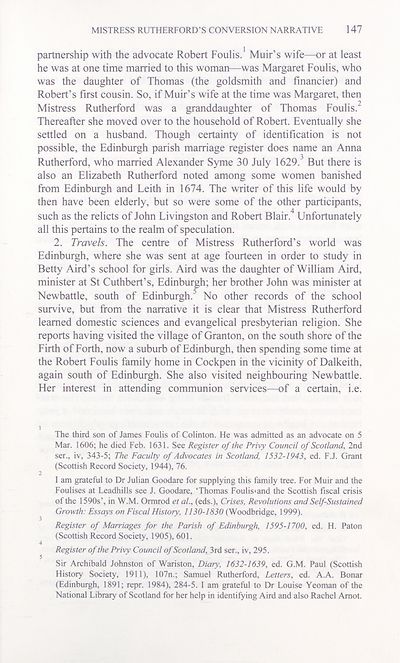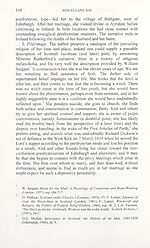Series 5 > Miscellany [of the Scottish History Society] XIII
(162) Page 147
Download files
Complete book:
Individual page:
Thumbnail gallery: Grid view | List view

MISTRESS RUTHERFORD’S CONVERSION NARRATIVE 147
partnership with the advocate Robert Foulis.1 Muir’s wife—or at least
he was at one time married to this woman—was Margaret Foulis, who
was the daughter of Thomas (the goldsmith and financier) and
Robert’s first cousin. So, if Muir’s wife at the time was Margaret, then
Mistress Rutherford was a granddaughter of Thomas Foulis.2
Thereafter she moved over to the household of Robert. Eventually she
settled on a husband. Though certainty of identification is not
possible, the Edinburgh parish marriage register does name an Anna
Rutherford, who married Alexander Syme 30 July 1629.3 But there is
also an Elizabeth Rutherford noted among some women banished
from Edinburgh and Leith in 1674. The writer of this life would by
then have been elderly, but so were some of the other participants,
such as the relicts of John Livingston and Robert Blair. Unfortunately
all this pertains to the realm of speculation.
2. Travels. The centre of Mistress Rutherford’s world was
Edinburgh, where she was sent at age fourteen in order to study in
Betty Aird’s school for girls. Aird was the daughter of William Aird,
minister at St Cuthbert’s, Edinburgh; her brother John was minister at
Newbattle, south of Edinburgh.5 No other records of the school
survive, but from the narrative it is clear that Mistress Rutherford
learned domestic sciences and evangelical presbyterian religion. She
reports having visited the village of Granton, on the south shore of the
Firth of Forth, now a suburb of Edinburgh, then spending some time at
the Robert Foulis family home in Cockpen in the vicinity of Dalkeith,
again south of Edinburgh. She also visited neighbouring Newbattle.
Her interest in attending communion services—of a certain, i.e.
The third son of James Foulis of Colinton. He was admitted as an advocate on 5
Mar. 1606; he died Feb. 1631. See Register of the Privy Council of Scotland, 2nd
sen, iv, 343-5; The Faculty of Advocates in Scotland, 1532-1943, ed. F.J. Grant
(Scottish Record Society, 1944), 76.
I am grateful to Dr Julian Goodare for supplying this family tree. For Muir and the
Foulises at Leadhills see J. Goodare, ‘Thomas Foulis>and the Scottish fiscal crisis
of the 1590s’, in W.M. Ormrod et al., (eds.). Crises, Revolutions and Self-Sustained
Growth: Essays on Fiscal History, 1130-1830 (Woodbridge, 1999).
Register of Marriages for the Parish of Edinburgh, 1595-1700, ed. H. Paton
(Scottish Record Society, 1905), 601.
Register of the Privy Council of Scotland, 3rd sen, iv, 295.
Sir Archibald Johnston of Wariston, Diary, 1632-1639, ed. G.M. Paul (Scottish
History Society, 1911), 107n.; Samuel Rutherford, Letters, ed. A.A. Bonar
(Edinburgh, 1891; repr. 1984), 284-5. I am grateful to Dr Louise Yeoman of the
National Library of Scotland for her help in identifying Aird and also Rachel Amot.
partnership with the advocate Robert Foulis.1 Muir’s wife—or at least
he was at one time married to this woman—was Margaret Foulis, who
was the daughter of Thomas (the goldsmith and financier) and
Robert’s first cousin. So, if Muir’s wife at the time was Margaret, then
Mistress Rutherford was a granddaughter of Thomas Foulis.2
Thereafter she moved over to the household of Robert. Eventually she
settled on a husband. Though certainty of identification is not
possible, the Edinburgh parish marriage register does name an Anna
Rutherford, who married Alexander Syme 30 July 1629.3 But there is
also an Elizabeth Rutherford noted among some women banished
from Edinburgh and Leith in 1674. The writer of this life would by
then have been elderly, but so were some of the other participants,
such as the relicts of John Livingston and Robert Blair. Unfortunately
all this pertains to the realm of speculation.
2. Travels. The centre of Mistress Rutherford’s world was
Edinburgh, where she was sent at age fourteen in order to study in
Betty Aird’s school for girls. Aird was the daughter of William Aird,
minister at St Cuthbert’s, Edinburgh; her brother John was minister at
Newbattle, south of Edinburgh.5 No other records of the school
survive, but from the narrative it is clear that Mistress Rutherford
learned domestic sciences and evangelical presbyterian religion. She
reports having visited the village of Granton, on the south shore of the
Firth of Forth, now a suburb of Edinburgh, then spending some time at
the Robert Foulis family home in Cockpen in the vicinity of Dalkeith,
again south of Edinburgh. She also visited neighbouring Newbattle.
Her interest in attending communion services—of a certain, i.e.
The third son of James Foulis of Colinton. He was admitted as an advocate on 5
Mar. 1606; he died Feb. 1631. See Register of the Privy Council of Scotland, 2nd
sen, iv, 343-5; The Faculty of Advocates in Scotland, 1532-1943, ed. F.J. Grant
(Scottish Record Society, 1944), 76.
I am grateful to Dr Julian Goodare for supplying this family tree. For Muir and the
Foulises at Leadhills see J. Goodare, ‘Thomas Foulis>and the Scottish fiscal crisis
of the 1590s’, in W.M. Ormrod et al., (eds.). Crises, Revolutions and Self-Sustained
Growth: Essays on Fiscal History, 1130-1830 (Woodbridge, 1999).
Register of Marriages for the Parish of Edinburgh, 1595-1700, ed. H. Paton
(Scottish Record Society, 1905), 601.
Register of the Privy Council of Scotland, 3rd sen, iv, 295.
Sir Archibald Johnston of Wariston, Diary, 1632-1639, ed. G.M. Paul (Scottish
History Society, 1911), 107n.; Samuel Rutherford, Letters, ed. A.A. Bonar
(Edinburgh, 1891; repr. 1984), 284-5. I am grateful to Dr Louise Yeoman of the
National Library of Scotland for her help in identifying Aird and also Rachel Amot.
Set display mode to:
![]() Universal Viewer |
Universal Viewer | ![]() Mirador |
Large image | Transcription
Mirador |
Large image | Transcription
Images and transcriptions on this page, including medium image downloads, may be used under the Creative Commons Attribution 4.0 International Licence unless otherwise stated. ![]()
| Scottish History Society volumes > Series 5 > Miscellany [of the Scottish History Society] XIII > (162) Page 147 |
|---|
| Permanent URL | https://digital.nls.uk/127315473 |
|---|
| Description | Over 180 volumes, published by the Scottish History Society, containing original sources on Scotland's history and people. With a wide range of subjects, the books collectively cover all periods from the 12th to 20th centuries, and reflect changing trends in Scottish history. Sources are accompanied by scholarly interpretation, references and bibliographies. Volumes are usually published annually, and more digitised volumes will be added as they become available. |
|---|

![[Page 146]Early seventeenth-century Scottish conversion narrative](https://deriv.nls.uk/dcn4/1273/1546/127315463.4.jpg)
